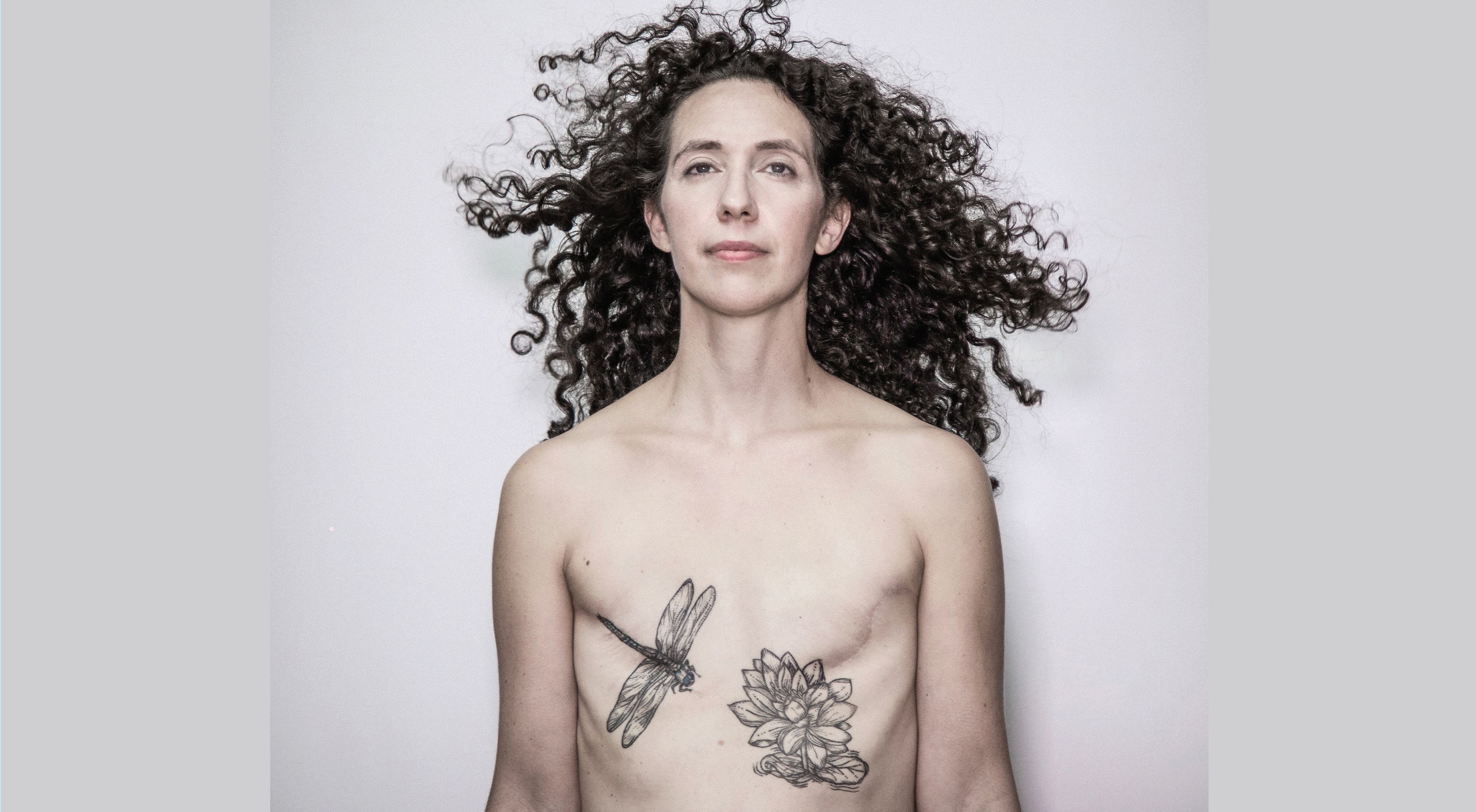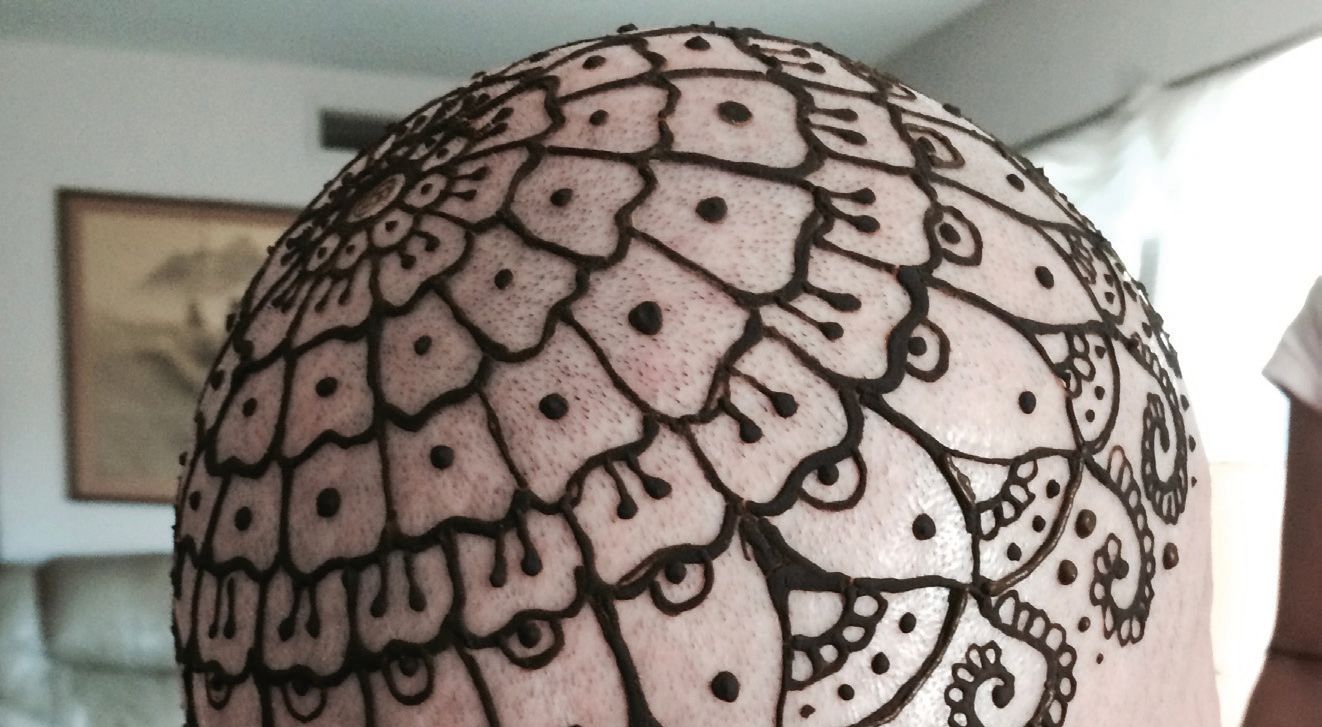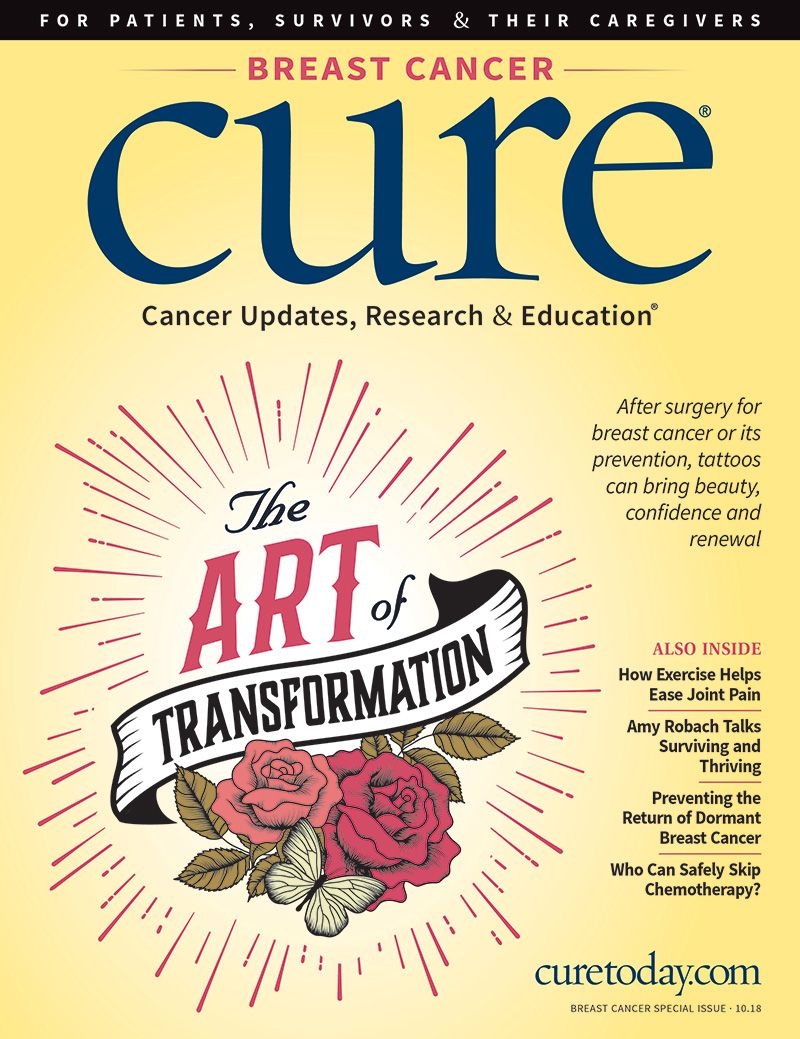Publication
Article
CURE
The Art of Transformation After a Cancer Diagnosis
Author(s):
After surgery for breast cancer or its prevention, tattoos can bring beauty, confidence and renewal.
REBECCA PINE gained a sense of control when she got decorative tattoos on her chest after a bilateral mastectomy. - BEATRICE DE GEA

REBECCA PINE gained a sense of control when she got decorative tattoos on her chest after a bilateral mastectomy. - BEATRICE DE GEA
Rebecca Pine feels empowered every time she catches sight of her bare chest in the mirror. A tattoo of a dragonfly masks a mastectomy scar on her right side, and a lotus tattoo sits just below a similar scar on the left. “These images resonated with me because both the dragonfly and the lotus flower are about transformation,” says the Merrick, New York, resident, who received a diagnosis of stage 1 invasive ductal carcinoma breast cancer in 2009 at age 33. “The dragonfly starts life underwater. It crawls onto land when it matures, unfolds its shimmering wings and takes flight. The lotus needs muddy waters to form its beautiful blossoms.”
MAKING A STATEMENT WITH TATTOOS
Pine spent several years thinking about the artwork she wanted to have permanently sketched on her chest before seeking the services of a tattoo artist in 2015. She’s among a growing number of women affected by breast cancer who are choosing to transform their post-surgery bodies into works of art.
Mastectomy tattoos, sometimes called paramedical body art, serve many purposes: They conceal scars, make a symbolic statement, restore a sense of normalcy to reconstructed breasts that may lack shape or nipples, and provide a sense of control to women who’ve had cancer or who’ve had surgery because they’re predisposed to the disease. “I didn’t have a say about having cancer or losing my breasts,” Pine says, “but I could choose how I wanted to look and feel about myself going forward.”
Tattooing of nipples and areolae following breast reconstruction surgery has been done for years. Over time, tattoo artists, plastic surgeons and other professionals have honed their skills to create tattooed nipples that appear three-dimensional. “A skilled tattoo artist can create the illusion of depth and protrusion using different shades of ink,” says Holly Feneht, a tattoo artist and owner of The Gilded Lily (gildedlilydesign.com), a paramedical body art studio in Santa Clarita, California.
When a nipple-sparing mastectomy isn’t feasible, women undergoing breast reconstruction who want the appearance of nipples can either get a nipple tattoo or undergo another surgery to rebuild the nipple and areola using tissue taken from the newly created breast or another part of the body, such as the thigh. Even with this surgery, a nipple tattoo is often necessary to make the reconstructed breast look more natural.
Most of the women who come to Feneht for postreconstruction nipple tattoos are referred by their plastic surgeons or oncologists. They range in age from 20 to 80, and many are getting tattoos for the first time. “They want a nipple tattoo so they will look more like their natural selves,” Feneht says. In addition, a growing number of women are foregoing the nipple tattoo in favor of a decorative image.
MICHELLE LINDLE got a floral tattoo on one reconstructed breast because her nipple could not be preserved. She learned she had breast cancer after a horse-riding accident left her with a bruised chest, which attracted her attention to a growing lump there. - PHOTO COURTESY OF MICHELLE LINDLE

MICHELLE LINDLE got a floral tattoo on one reconstructed breast because her nipple could not be preserved. She learned she had breast cancer after a horse-riding accident left her with a bruised chest, which attracted her attention to a growing lump there. - PHOTO COURTESY OF MICHELLE LINDLE
Michelle Lindle, of Newbury Park, California, sought Feneht’s services after undergoing a double mastectomy and reconstructive surgery in 2015 to treat stage 2 HER2-positive breast cancer. Lindle was able to keep her right nipple and chose to adorn her nipple-less left breast with a colorful array of delicate flowers. “After the trauma of surgeries and chemotherapy, a tattoo can help you feel prettier and more feminine,” Lindle says. “It also gives you a sense of regaining control of your body and what is happening to it.”
Whether clients want nipple or decorative tattoos, Feneht encourages taking small steps. “We can always make a decorative tattoo larger and more extravagant or add more color saturation to a nipple or areola,” she says.
ARE TATTOOS SAFE?
The time and cost involved depend largely on the tattoo’s size and details, as well as the person doing the work. On average, tattoo artists charge from $120 to $200 per hour. Nipple and areola tattoos can take up to two hours, with a second session used as a follow-up to make minor alterations to color saturation and size. Depending on the size of a decorative tattoo, multiple sessions lasting two hours or longer may be needed.
The very act of puncturing skin with a needle to inject ink puts a person at risk of infection; however, no evidence suggests that getting a tattoo poses a major health problem, increases the risk of cancer or recurrence, or interferes with breast cancer screenings. “Women who have had radiation treatments or who have extensive scarring have a slightly higher risk of infection because the skin is more fragile,” says Emily Clark, a physician assistant at Memorial Sloan Kettering Cancer Center in New York City.
Rarely, a person may have an allergic reaction to the tattoo ink, which is made from a mixture of organic pigments and natural preservatives. Signs of infection or other problems include fever; yellow or green discharge; muscle aches; and prolonged, severe redness, pain and swelling at the tattoo site. (Some degree of redness and swelling for just a day or two is normal.)
Clark recommends waiting three to five months after breast surgery before getting a tattoo and always consulting a doctor first. “The surgical incisions should be fully healed. Scars that are still healing won’t absorb tattoo pigment well and may be more prone to infection,” she says. Even patients with lymphedema — fluid retention in limbs due to the removal of lymph nodes — can get chest tattoos, just not on affected arms or legs. “Tattooing doesn’t increase the risk of complications from lymphedema,” Clark says. “But again, you should always consult with your physician to make sure that tattooing doesn’t pose a problem.”
After radiation, it’s important to delay tattoos until any radiation dermatitis (redness or skin breakdown) has cleared up and avoid tattooing any folds in the skin, which tend to be more affected by radiation therapy. A doctor may prescribe antibiotics to decrease infection risk and, if requested, a topical numbing cream to use an hour before the procedure. “Tattooing is generally less painful for women who have had mastectomies, because the nerves in breast skin are somewhat numb,” Clark says. Expect to feel some pressure and vibrations, as well as a bit more pain or discomfort in nonsurgical areas.
For those heading to a medical office for a tattoo, Feneht recommends finding out what type of ink will be used. “Many medical professionals use cosmetic inks and pigments. Cosmetic ink is ground finer and has smaller molecules than permanent ink, which means your body will break down the ink faster,” she says. As a result, a nipple tattoo could fade away within two years. Tattoos made with permanent ink may need an occasional touchup but should last forever.
It’s up to health insurers to decide whether to cover nipple and areola tattooing performed at a medical facility, plastic surgeon’s office or tattoo studio, and patients may need to fight for it. “In most cases, if a nipple tattoo is performed by a medical professional, it will be covered by the patient’s insurance,” Clark says. “However, patients should speak with their insurance carriers regarding coverage for this procedure.”
TAPPING INTO HENNA HAPPINESS
SUSAN SAYLES got a temporary henna tattoo after losing her hair due to chemotherapy. - PHOTO COURTESY OF SUSAN SAYLES

SUSAN SAYLES got a temporary henna tattoo after losing her hair due to chemotherapy. - PHOTO COURTESY OF SUSAN SAYLES
The availability of coverage for body art created in tattoo studios, as opposed to in medical settings, varies. Some insurers consider nipple and areola tattoos labeled “paramedical” eligible for coverage, but companies typically don’t pay for decorative tattoos, Feneht says. Some women simply aren’t comfortable with the idea of having a drawing or saying permanently displayed on their skin. For them, temporary henna tattoos are an option.
Henna is a natural dye that comes from a flowering shrub that grows from North Africa to the Middle East to South Asia. In India, the art of staining the skin with henna is known as mehndi. “Henna has been used for body art for about 5,000 years. It’s a tradition that’s said to bring joy and blessings to the wearer,” says Danila Marilú, a henna artist in Dallas who creates henna crowns on women who have lost their hair to cancer treatments.
About three weeks after her first chemotherapy session, Dallas resident Susan Sayles shaved what was left of her hair and went to Marilú for a henna crown. “People can’t tell from looking at you if you have diabetes or heart disease, but there’s no way to hide a bald head on a woman and all that it represents. I knew people would stare. I figured I might as well give them something to look at,” says Sayles, who was 58 and working as a nurse manager at Texas Oncology when she received a diagnosis of stage 2b breast cancer. “I felt proud while sporting my henna crown. I took a negative situation and did something courageous.”
During the process, a henna artist draws intricate designs on a woman’s scalp using henna paste. The wearer keeps the design moist for six to 12 hours with a mixture of sugar and lemon juice or water, and then uses a towel to slough off the hardened paste. A reddish-brown stain remains. Henna tattoos can last three weeks or longer, depending on upkeep and activities — sweat and water cause faster fading. Wearing a shower cap and regularly applying coconut oil helps the stain last longer. Henna also can be used on eyebrows, although the effects last only about two weeks.
Not all products labeled as henna are safe, however. “Henna that’s black often contains a hair dye called paraphenylenediamine, or PPD, that can cause dangerous skin reactions in some people,” says henna artist Amanda Joy Gilbert, owner of Henna Crowns of Courage (crownsofcourage.org), a nonprofit organization in Grand Rapids, Michigan. Henna should always be dark brown when applied. It will dry to a bright orange stain that oxidizes to a reddish-brown tint in 48 to 72 hours. “Your skin is your largest organ, so you definitely want to use the safest henna,” Gilbert says. Professional henna artists make their own paste, mixing the dye with other natural ingredients, such as lavender essential oil, lemon juice, sugar and water. One way to ensure getting the safest stain is to ask the artist for a list of ingredients and share it with a doctor prior to getting the tattoo.
Depending on the design, getting a henna crown can take anywhere from 90 minutes to three hours. “Your scalp is very sensitive, so initially it feels a bit cold and ticklish,” Sayles says, “but then it becomes a soothing, almost therapeutic experience.” Fees vary but typically start around $100 per hour. Some organizations, such as Henna Crowns of Courage, provide free henna crowns to women and children undergoing cancer treatments. Others that provide this service for free are SARAHENNA in Washington state (www.sarahenna. com/crowns) and Henna Me Beautiful in the Santa Barbara and Northridge areas of California (hennamebeautiful. com/henna-crowns.html).
Before doing a crown, Gilbert spends time with a client and her loved ones to get a sense of who she is as a person. “I might incorporate certain words or phrases into the design, sort of like an empowering mantra,” she says. Gilbert notes that, in the Hindu tradition, henna designs symbolize awakening the inner light. “It’s a joy for me to bring out the inner light of women who have been through so much by giving them a crown of courage,” she says.




